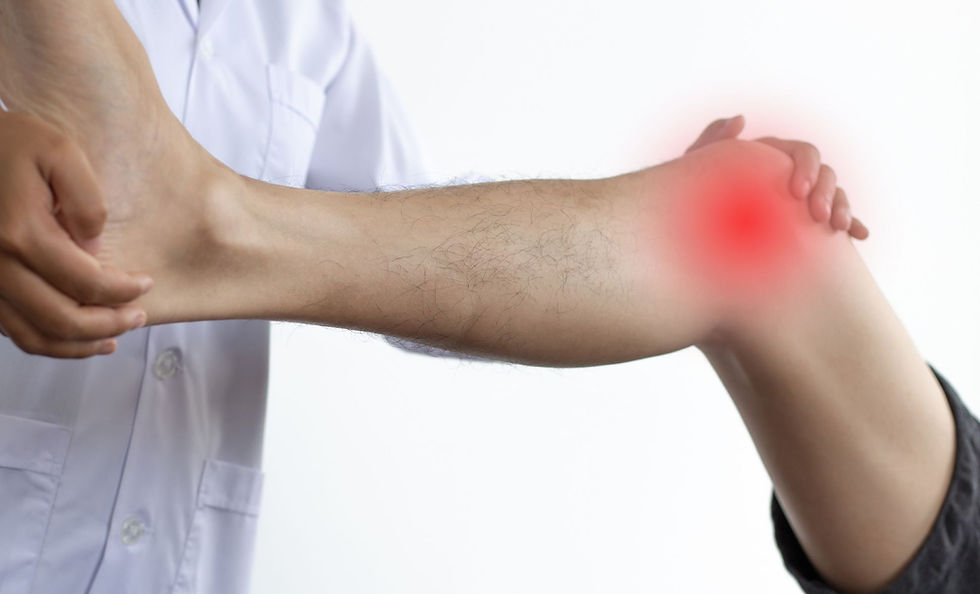7 Easy & Effective Hypermobility Exercises
- Dr. George Cheriyan, DO

- Nov 30, 2023
- 3 min read
Updated: Jan 8, 2024
While there is no cure for hypermobility, exercising is one of the most effective ways to manage it. But when you are living with hypermobile joints, not every exercise works.
The hypermobility exercises below aren't only effective but also easy to do, easing your discomforts and empowering you to live a more comfortable and fulfilling life. But before you begin, check in with the Osteohealer™ to ensure the exercises are safe and appropriate for your specific condition.

1. Squat
Squats strengthen your core and the muscles of your lower body.
How to Do It
Start in an upright standing position, with your feet shoulder-width apart.
Bend your knees and hips into a mini squat position, then straighten your legs and repeat.
Ensure your back is straight, and avoid letting your knees bend past your toes.
Repeat five times.
2. Plank
Planks target your core, lower, and upper body muscles. Regularly performing side planks can strengthen the core muscles, providing better support and stability.
How to Do It
First, lie on your forearms and toes and hold the position.
Prevent your back from overarching.
Hold the position for 30 seconds.
Repeat three times.
3. Hamstring Curls
Hamstring curls engage your glutes and hamstrings, promoting flexibility in the back of your thighs and reducing the risk of tightness and discomfort. This is a great exercise to improve core strength and lumbar back muscles.
How to Do It
Sit on the floor with your legs extended in front of you.
Reach towards your toes, keeping your back straight.
Hold for 30 seconds and repeat three times.
4. Bird Dog
The bird dog exercise targets the erector spinae, rectus abdominis, and glutes. It benefits these muscles, allowing for the body's correct movement, control, and stability.
How to Do It
Position yourself on your hands and knees, with knees under your hips and hands tucked under your shoulders.
Brace your core and raise your left leg till it aligns with your torso. Simultaneously, kick back your right leg at the opposite angle without arching your lower back.
Hold the position for 3 seconds.
Repeat with your left leg and right arm.
Repeat ten times, alternating sides.
5. Dead Bug
The dead bug targets core muscles, including the transverse abdominis, rectus abdominis, obliques, and pelvic floor. The exercise enhances core strength and boosts trunk and hip stability.
How to Do It
Start by lying face up with both arms extended towards the ceiling.
Extend your legs upward by 90 degrees.
Exhale to lower your ribcage, and try to flatten your back onto the floor by rotating your pelvis upwards and exerting pressure on your core.
Extend one leg, ensuring it's straight at your hip and knee, and place the opposite arm.
Lower the leg without arching your lower back.
Repeat with the other leg and the opposite arm.
Repeat 20 times.
6. Glute Bridge
Glute bridges are targeted at the gluteus maximus. This exercise helps to strengthen your core, buttocks, and back muscles.
How to Do It
Lie down facing up with knees bent and arms flat to either side.
Lift your butt off the ground by exerting pressure on your core.
Hold this position for 5 seconds, and slowly lower your back.
Repeat ten times.
7. Pushups
Push-ups primarily strengthen the chest, shoulders, and triceps while also engaging the core.
How to Do It
Lie on the floor with your face facing downwards.
Strike a plank pose.
Slowly push up and down, keeping your body straight and your elbows pointing towards your toes.
Repeat ten times.
Living With Hypermobility? Consult With the Osteohealer™ to Feel the Healing!
Hypermobility can be challenging, but it's important to remember that it's also a unique trait. With proper management and exercise, you can learn to live a fulfilling life without letting hypermobility hold you back.
The Osteohealer™ will examine you to develop an individualized treatment plan unique to your condition and the severity level. Book an appointment today to feel the healing.



